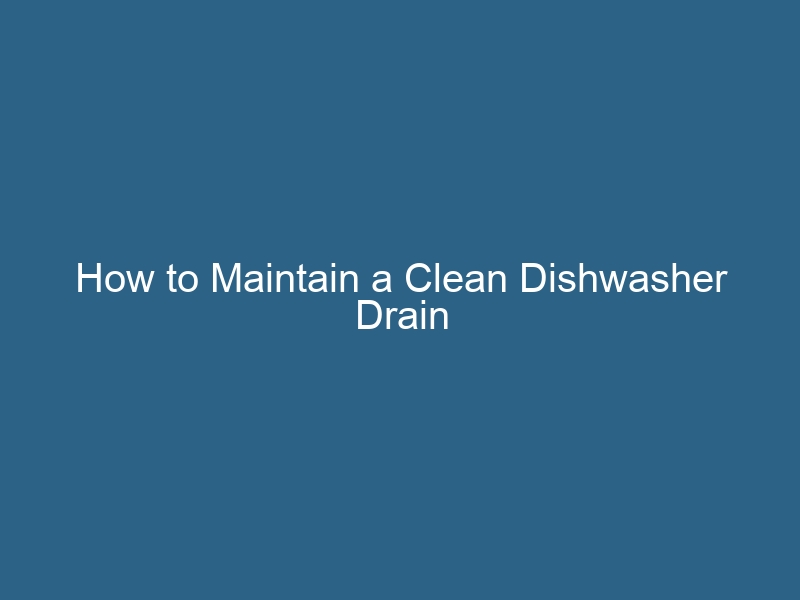Quck answer
Cleaning a dishwasher drain is important to maintain its efficiency and prevent clogs. Here are the steps to clean a dishwasher drain:
1. Start by disconnecting the dishwasher from the power source and turning off the water supply.
2. Remove the bottom rack and any food debris or objects from the drain area.
3. Use a toothbrush or a small brush to scrub the drain opening and remove any gunk or buildup.
4. Pour a mixture of hot water and vinegar down the drain to loosen and dissolve any remaining residue.
5. Use a pipe cleaner or a straightened wire hanger to remove any stubborn clogs or debris.
6. Rinse the drain with hot water and reassemble the dishwasher.
Regularly cleaning the dishwasher drain will help maintain its performance and prolong its lifespan.
It is important to regularly clean the drain of your dishwasher to ensure that your dishes come out clean and that your appliance is working at its best.
All dishwasher drains are equipped with filters that are designed to catch food debris and prevent clogs. However, if these filters are not cleaned, clogs can still occur. The good news is that it is much easier to fix a clog by cleaning the filter than it is to repair a clog further down the drain pipe.
Locating and Removing Dishwasher Filters
To begin, you will need to find the filter and drain in your dishwasher. These are typically located on the floor of the dishwasher, so start by removing the bottom rack for easy access. Dishwasher filters usually consist of two parts: a screen that catches larger debris and a cylindrical filter with a finer mesh that catches grease before it enters the drain and solidifies into a clog. Twist the cylindrical filter until it lifts out, then you can also remove the screen.
In some dishwasher models, you may need to remove the blade before you can access the filter. The blades are situated on top of a mount that can be easily twisted off by hand. Simply turn it counterclockwise until the blade lifts out. Then, remove any remaining parts until you can lift out the filter. Another common scenario is basket filters that are held in place with screws.
Cleaning Dishwasher Filters
Start by scraping any large debris from both filters into the trash. Next, apply a small amount of grease-fighting liquid dish soap to the filters and use an old toothbrush to work it into the mesh. For stubborn material on the finer mesh filters, fill your sink with hot water and scrub the filters underwater. Alternatively, you can also scrub them under running water.
After cleaning the filters, continue to run warm water in your sink drain for several minutes to ensure that any remaining grease is flushed out.
Cleaning Dishwasher Drains
If you are unsure whether your Whirpool dishwasher was not draining properly due to dirty filters or because of a clog in the drain, unplug the dishwasher and inspect the drain now that the filters have been removed. Use a flashlight to check for any gunk or debris at the mouth of the drain, which may have been pushed through the filters if they have been dirty for a while. Carefully remove any debris with a cloth or use an auger to pierce and remove a solid clog.
If you cannot find anything in the dishwasher drain itself, check underneath your kitchen sink where the dishwasher drain hose connects to the main drain. If your kitchen sink is also experiencing drainage issues, the problem may be in the main drain pipe. However, if your sink drains properly and only the dishwasher is affected, you can remove the dishwasher drain pipe to inspect the connection or the pipe itself for any clogs.
Dishwasher drain pipes are typically transparent, so you can easily identify a clog. If you find one, remove the pipe at both ends and try to push the clog out using a straightened wire coat hanger or by using a blast of water from an outdoor hose. This method is also effective for removing black gunk from a dishwasher drain hose.
Checking the Drainage of the Dishwasher
After putting the dishwasher back together, perform a trial run without any dishes inside to ensure that it drains correctly. If you continue to experience problems, contact a qualified plumber. Otherwise, maintain the proper functioning of your dishwasher by scraping off and rinsing all dishes before loading them in order to prevent future drainage issues.


